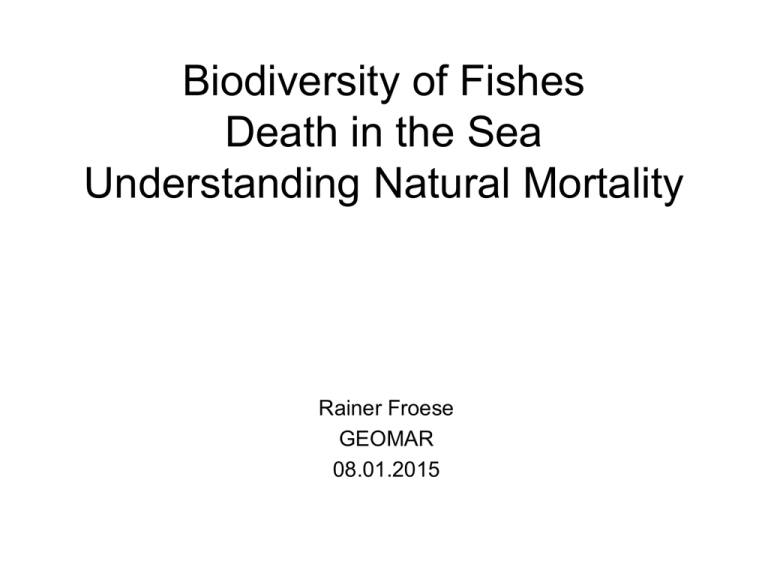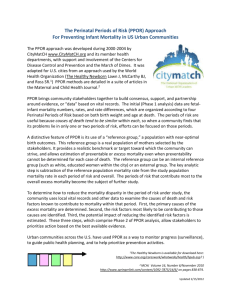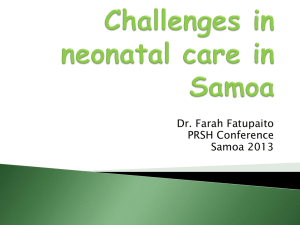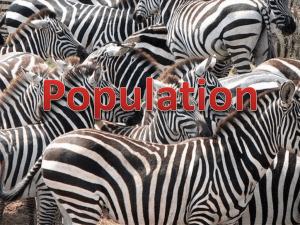M - FishBase
advertisement

Biodiversity of Fishes Death in the Sea Understanding Natural Mortality Rainer Froese GEOMAR 08.01.2015 What is Natural Mortality? Proportion of fishes dying from natural causes, such as: • Predation • Disease / parasites • Accidents, natural disasters • Old age The M Equation Instantaneous rate of natural mortality of M: Dt / Nt = Mt Where t is the age in years Dt is the number of deaths at age t Nt is the population size at age t The M Equation Probability of survival (lt) to age t: lt = e –M t Where M is the instantaneous rate of natural mortality t is the age in years lt ranges from 1.0 at birth to near zero at maximum age The M Equation Number of survivors N to age t : Nt = N0 e –M t Where N0 is the number of individuals at start age t=0 Nt is the number of individuals at age t Cohort numbers if M = 0.2 1200 Nt = Nts * exp(-M*(t - ts)) Cohort numbers 1000 800 600 400 200 0 0 5 10 15 Cohort age (years) 20 25 Constant Value of M for Adults (in species with indeterminate growth: fishes, reptiles, invertebrates, ..) • M is typically higher for larvae, juveniles, and very old individuals, but reasonably constant during adult life • This stems from a balance between intrinsic and extrinsic mortality: – Intrinsic mortality increases with age due to wear and tear and accumulation of harmful mutations acting late in life – Extrinsic mortality decreases with size and experience The M Equations If M is different in years 1, 2, 3 and constant thereafter lt = e –(M1+M2+M3+Mconstant*(t-3)) Nt = N0 e –(M1+M2+M3+Mconstant*(t-3)) M is Death Rate in a Stable Population In a stable, equilibrium population – The number of spawners dying per year must equal the number of ‘new’ spawners per year – Every spawner, when it dies, is replaced by one new spawner, the life-time reproductive rate is 1/1 = 1 – If the average duration of reproductive life dr is several years, the annual reproductive rate α is α = 1 / dr The P/B ratio is M (Allen 1971) In a stable, equilibrium population – Biomass gained by production (P) must equal biomass lost (Blost) due to mortality – M is the instantaneous loss in numbers relative to the initial number: Nlost / N = M – If we assume an average weight per individual, then we have biomass: Blost / B = M – If Blost = P then P / B = M Reference: Allen, K.R. 1971. Relation between production and biomass. Journal of the Fisheries Research Board of Canada, 1971, 28(10): 1573-1581 Pauly’s 1980 Equation log M = -0.0066 – 0.279 log L∞ + 0.6543 log K + 0.4634 log T Where L∞ and K are parameters of the von Bertalanffy growth function and T is the mean annual surface temperature in °C Reference: Pauly, D. 1980. On the interrelationships between natural mortality, growth parameters, and mean environmental temperature in 175 fish stocks. J. Cons. Int. Explor. Mer. 39(2):175-192. Jensen’s 1996 Equation M = 1.5 K Where K is a parameter of the von Bertalanffy growth function Reference: Jensen, A.L. 1996. Beverton and Holt life history invariants result from optimal trade-off of reproduction and survival. Canadian Journal of Fisheries and Aquatic Sciences:53:820-822 M = 1.5 K 100 1:1 M observed 10 1 0.1 0.01 0.01 0.1 1 10 100 M = 1.5 K Plot of observed natural mortality M versus estimates from growth coefficient K with M = 1.5 K, for 272 populations of 181 species of fishes. The 1:1 line where observations equal estimates is shown. Robust regression analysis of log observed M versus log(1.5 K) with intercept removed explained 82% of the variance with a slope not significantly different from unity (slope = 0.977, 95% CL = 0.923 – 1.03, n = 272, r2 = 0.8230). Data from FishBase 11/2006 [File: M_Data.xls] Hoenig’s 1984 Equation ln M = 1.44 – 0.984 * ln tmax Where tmax is the longevity or maximum age reported for a population Reference: Hoenig, J.M., 1984. Empirical use of longevity data to estimate mortality rates. Fish. Bull. (US) 81(4). Charnov’s 1993 Equation Life History Summary Note: Blue line is not to scale. Froese and Pauly 2013. Fish Stocks, p. 477-487 In Encyclopedia of Biodiversity, Academic Press Fishing Kills Fish Z=M+F Where Z = total mortality rate F = mortality caused my fishing Total Mortality of Turbot Numbers at age in survey catches of North Sea turbot (Scophthalmus maximus). Points at the left are not fully selected by the gear. The point at the right is a single, rare survivor of fishing. The absolute slope Z = 0.82 represents total mortality from natural causes M and from fishing F. Conclusions • Natural mortality M is high in early life and near constant in adults • M determines life expectancy, growth and reproduction (and everything else) • Total mortality is Z = M + F • Death rules Exercises • Select a species from FishBase with several estimates of natural mortality (M is under Growth) • Discuss M relative to other species (M-K Graph) • Determine mean M/K ratio • Determine adult life expectancy E











